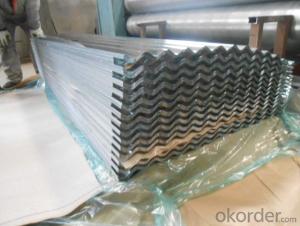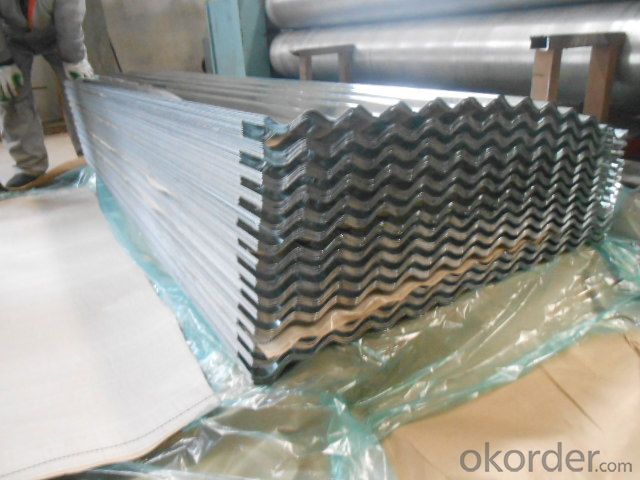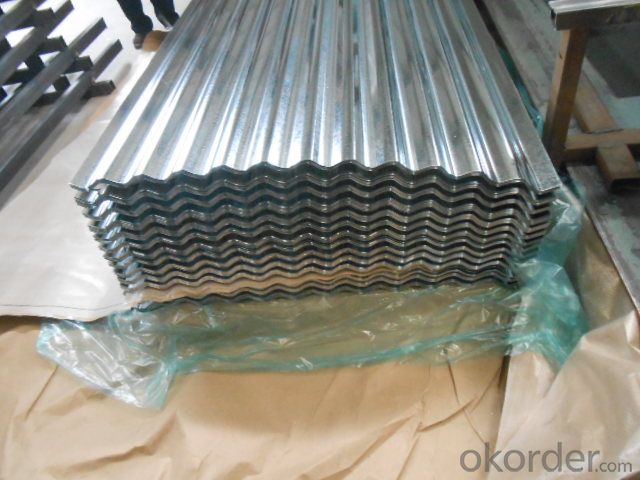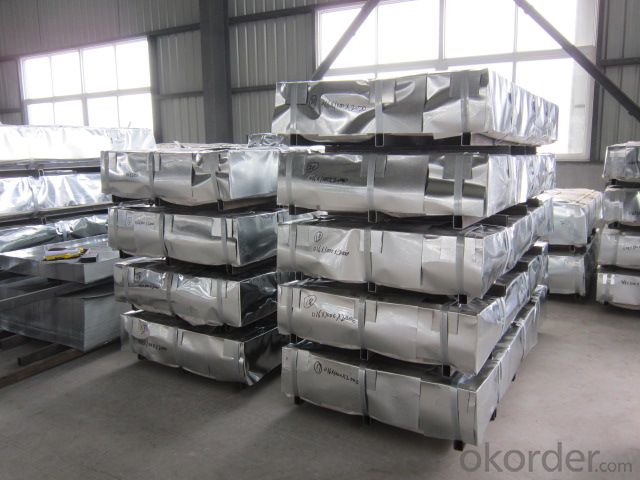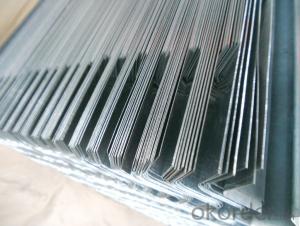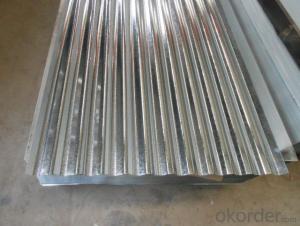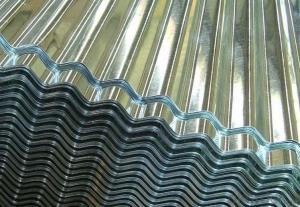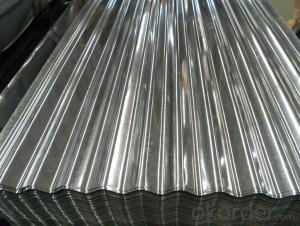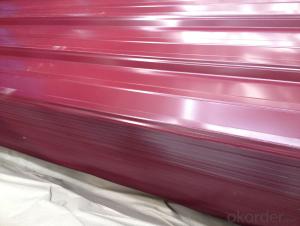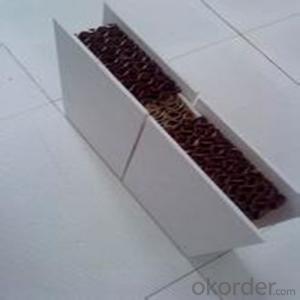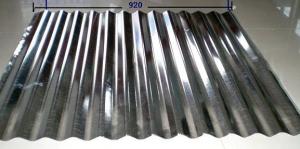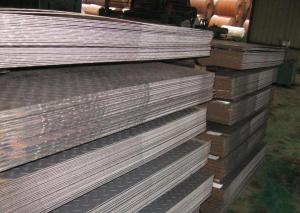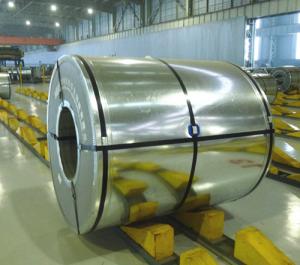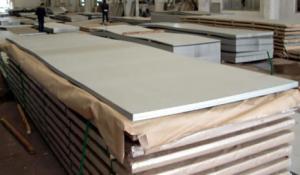Corrugated Hot-Dipped Galvanized Steel Sheets
- Loading Port:
- Tianjin
- Payment Terms:
- TT OR LC
- Min Order Qty:
- 50 m.t.
- Supply Capability:
- 1000 m.t./month
OKorder Service Pledge
OKorder Financial Service
You Might Also Like
Description:
Corrugated steel sheet is the steel plate which has been wave formed with the cold rolling treatment, trough especial coated dispose
Pressing steel panel with the clear line, and many colors for choice, suitable for any different building style materials, achieving satisfy effects;
Pressing steel panel can be freely incised, it can satisfy the especially designing demands. It apply on convenient construction, and anti-seismic performance, fire proof, waterproof, free of maintenance, ect.
Base sheet : galvanized steel sheet, pre painted galvanized steel sheet


Application:
With excellent cold bending molded manufacturablity, good decoration effect, strong anti-corrosion ability, are also pollution-free and easily recycled. Accordingly, they can be used as final products and basic plates of color coated steel coils and widely applied in construction, home appliances, decoration, ect.
Pressing steel panel with the clear line, and many colors for choice, suitable for any different building style materials, achieving satisfy effects;
Product Specification:
Thickness tolerance: (+/-0.01mm)
Zinc coating: 50-180g/m2
Standard:jis g 3302, sgch
Package: 2- 3 ton/pallet
Specs: 0.14-0.8mm x 900mm x 2000mm
Width:700-1250mm( 750mm,900mm,1215mm,1250mm,1000mm the most common)
Surface:regular/mini/zero spangle, chromated, skin pass, dry etc.
Package:Standard seaworthy export packing: 3 layers of packing, inside is kraft paper,water plastic film is in the middle and outside GI steel ,sheet to be covered by steel strips with lock.
FAQ:
1.How many pieces for one package?
The pieces for one tone is decided by the thickness of the sheet, but we can make it according to your requirements in the reasonable range.
2. Do you have pallets for the package?
Yes, we must use pallets for the package in order to load.
3. Could you produce the sheets according to our design?
Yes, we can.
- Q: Can steel sheets be used for architectural applications?
- Yes, steel sheets can be used for architectural applications. They are commonly used in construction for various purposes such as roofing, cladding, and structural components due to their strength, durability, and versatility. Steel sheets offer design flexibility and can be customized to meet specific architectural requirements.
- Q: How do steel sheets handle expansion and contraction?
- Steel sheets handle expansion and contraction by allowing enough flexibility to accommodate changes in temperature. This is achieved through the inherent ductility and elasticity of steel, which enables it to expand and contract without significant deformation or damage. Additionally, steel sheets may be designed with specific expansion joints or gaps to further accommodate thermal changes and prevent buckling or warping.
- Q: Can steel sheets be formed into curved shapes?
- Indeed, curved shapes can be achieved with steel sheets by means of a technique referred to as cold forming or bending. Without the need for heating, cold forming entails exerting pressure upon the steel sheet to reshape it. Roll forming, press braking, and stamping are among the different methods employed to accomplish this process. The malleability of steel enables it to be effortlessly molded into curves, thereby rendering it a versatile substance suitable for a wide range of applications in sectors like construction, automotive, and aerospace.
- Q: What is the average thermal conductivity of steel sheets?
- The average thermal conductivity of steel sheets typically ranges from 15 to 50 Watts per meter Kelvin (W/m·K).
- Q: Can steel sheets be used for automotive exhaust systems?
- Yes, steel sheets can be used for automotive exhaust systems. Steel is a commonly used material for exhaust systems due to its durability, heat resistance, and cost-effectiveness. Steel sheets are often formed and welded to create the necessary components of an exhaust system, such as pipes, mufflers, and catalytic converters.
- Q: Can steel sheets be used for manufacturing containers or packaging?
- Yes, steel sheets can be used for manufacturing containers or packaging. Steel is a durable and strong material that provides excellent protection for goods during transportation and storage. It is commonly used in industries such as food and beverage, chemicals, and manufacturing for the production of containers and packaging.
- Q: Can steel sheets be used for containers or storage units?
- Yes, steel sheets can definitely be used for containers or storage units. Steel is a highly durable and strong material that is commonly used in the construction of containers and storage units due to its ability to withstand heavy loads and extreme weather conditions. Steel containers and storage units provide a secure and reliable solution for storing various items such as household goods, tools, equipment, and even larger items like vehicles. Steel sheets used for containers and storage units are often reinforced with additional features such as locking mechanisms, insulation, and ventilation to enhance their functionality. Additionally, steel containers and storage units are also portable and can be easily transported to different locations if needed. Overall, steel sheets are an excellent choice for containers and storage units due to their strength, durability, and versatility.
- Q: Can steel sheets be used for automotive manufacturing?
- Yes, steel sheets can be used for automotive manufacturing. Steel is a widely used material in the automotive industry due to its strength, durability, and cost-effectiveness. Steel sheets are commonly used in various automotive components such as body panels, chassis, frames, and structural reinforcements. They provide the necessary strength and rigidity required for the safety and performance of vehicles. Moreover, steel sheets can be easily formed and molded into different shapes, making them suitable for complex automotive designs. Additionally, steel is readily available, making it a popular choice for automotive manufacturers.
- Q: How do steel sheets handle water resistance?
- Due to their inherent properties and protective coatings, steel sheets generally possess excellent water resistance. Steel, being a non-porous material, does not readily allow water to penetrate. The smooth surface of steel sheets effectively prevents water seepage. Moreover, steel sheets are commonly coated with protective layers like galvanized zinc or paint, further enhancing their water resistance. Galvanized steel sheets are furnished with a zinc layer that acts as a moisture barrier and safeguards against corrosion. Zinc displays high resistance to water, and even if the coating sustains scratches, the sacrificial zinc layer shields the underlying steel from rusting. Consequently, galvanized steel sheets exhibit remarkable durability and water resistance, even under extreme conditions. Painted steel sheets represent another prevalent alternative. The paint serves as a safeguarding layer that obstructs direct contact between water and the steel surface. By forming a barrier, the paint effectively prevents moisture from infiltrating the steel and causing corrosion. Nevertheless, it is crucial to acknowledge that the quality and thickness of the paint coating significantly influence the water resistance of painted steel sheets. To summarize, steel sheets possess commendable water resistance due to their non-porous nature and the presence of protective coatings. Whether it is galvanized steel sheets with a zinc coating or painted steel sheets with a protective layer of paint, both choices offer reliable water resistance and prove suitable for diverse applications where exposure to water is a concern.
- Q: What are the common thicknesses for roofing steel sheets?
- Roofing steel sheets come in a variety of thicknesses, typically ranging from 0.4mm to 0.8mm. Nevertheless, the actual thickness required will be influenced by factors like the roofing system type, regional climate, and desired durability level. In regions prone to harsh weather, thicker steel sheets, like those around 0.8mm, are commonly employed, whereas thinner sheets may suffice for less challenging environments. Consulting with a roofing expert or manufacturer is crucial to ascertain the ideal thickness for a particular roofing undertaking.
Send your message to us
Corrugated Hot-Dipped Galvanized Steel Sheets
- Loading Port:
- Tianjin
- Payment Terms:
- TT OR LC
- Min Order Qty:
- 50 m.t.
- Supply Capability:
- 1000 m.t./month
OKorder Service Pledge
OKorder Financial Service
Similar products
Hot products
Hot Searches
Related keywords
